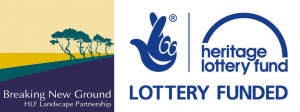As part of the Breaking New Ground scheme the Society has investigated the impact of flint on the built environment and culture of the Brecks.
Using a combination of fieldwork and archival research the study encompassed churches, other buildings, flint mines and miners.
Volunteers took part in training days which covered the practicalities of completing the research, whilst some also gained experience in flint knapping.
Our findings are published in the illustrated report: ![]() and on the pages of this website. Printed copies of the report are available from the society while stocks last. There is no charge for the report, but we do ask for a contribution towards the cost of postage & packing – this is £3 in the UK. To order, please email: info@brecsoc.org.uk. A leaflet is also available, and can be downloaded here.
and on the pages of this website. Printed copies of the report are available from the society while stocks last. There is no charge for the report, but we do ask for a contribution towards the cost of postage & packing – this is £3 in the UK. To order, please email: info@brecsoc.org.uk. A leaflet is also available, and can be downloaded here.
Flint in the Brecks had several individual but linked components: fieldwork and site visits to gunflint mining sites; archival research to find documentary evidence of the uses of flint; an oral history interview with Patrick Baldwin, who lives in a former flintmaster’s house in Brandon; flintknapping workshops; the production of an illustrated report, leaflet and these web pages. The project ran from July 2014 to February 2015, with Breckland Society members invited to take part and with promotion on the Society’s website and in the local press attracting further volunteers.
Two training sessions for fieldwork recording in July 2014 were attended by 19 volunteers, who subsequently recorded the sites of gunflint mines and the use of flint in churches and flint as a building material. Sixteen volunteers were trained in the access and use of archival records at the Norfolk Record Office on 5th September 2014 and carried out archival research. A refresher oral history training course was held for two experienced volunteers, who then conducted interviews. Four workshops in working with flint, held on during October 2014, were fully subscribed and, due to demand, two more were held in November 2014.
To ensure that there was a standardised recording system, volunteers were given a fieldwork recording form for the flint mine sites and another for recording flint in churches and vernacular buildings. They were also supplied with an archival recording form for any documentary evidence of flintmining and knapping and another for documentary evidence of flint as a building material.
The Society’s reputation for discovering new material was enhanced further with the discovery in the Norfolk Record Office of a diary written by Frank
Norgate, who lived in Santon Downham in the 1880s and 90s. He made many references to flintknapping and the flintknappers and even included a
diagram of a gunflint mine and a description of the mining process, a rare first-hand account. Key sections of the diary were transcribed as part of
the project.
The information gathered by the volunteers was used to prepare the information presented in this website. All the original recording forms and digital photographic records have been submitted to the Norfolk Record Office and copies deposited with the Norfolk Historic Environment Service; the Suffolk County Council Archaeological Service; and the Forestry Commission, East England District.

